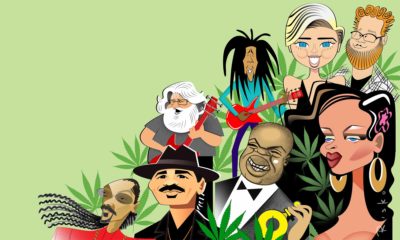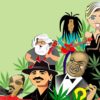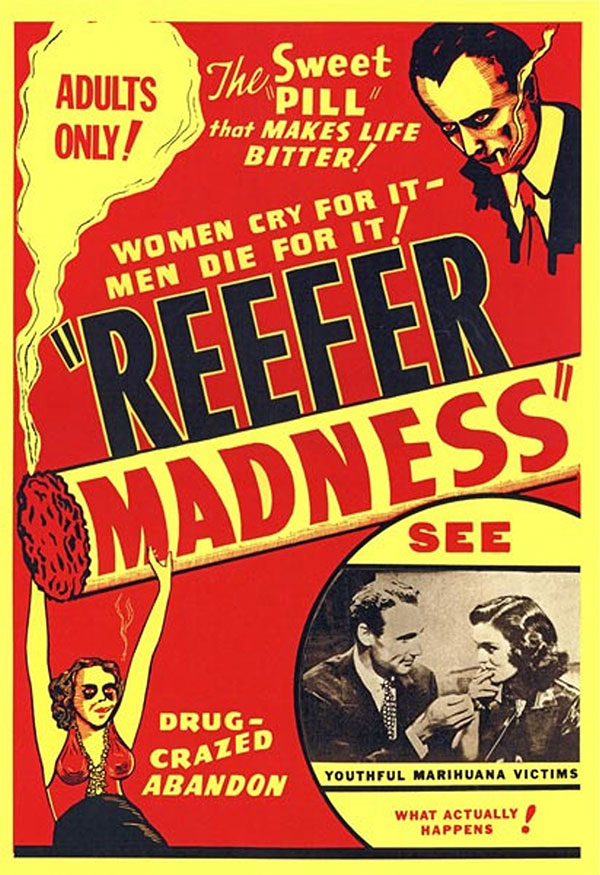
Culture
Why the Stoner Stereotype Keeps Shifting
Consistently blamed for an inconsistent list of societal hills, cannabis remains a powerful front in the culture war.
Before Alex Berenson, there was Merle Haggard. And before cannabis was blamed for America’s mass-shooting epidemic, there was the lazy stoner stereotype.
Country music’s conservative retort to the 1960s counterculture movement, Haggard recorded a string of reactionary anthems in the early 1970s—part of the backlash to the Great Society and the civil-rights movement that then-President Richard Nixon deliberately stoked to eke out a narrow election in 1968. Haggard derided the use of drugs, including cannabis (“Okie from Muskogee”), as well as perceived shiftiness and the welfare state (“Workin’ Man Blues”). In so doing, Haggard also, as author Josiah Hesse documented in Runner’s High, fueled a then-innovative way to denigrate and marginalize cannabis use.
Helped along by other bleary-eyed, shifty representations in film and music, Merle Haggard helped create the myth of the lazy stoner. This is indeed a myth, as recent research shows. Yet it is one that refuses to die, despite repeated debunking. But hidden in the tired allusions to Cheech & Chong and Spiccoli (has anyone over the age of 40 actually seen Fast Times at Ridgemont High?) and slightly fresher Seth Rogen references is a secret of American political and cultural discourse.
For at least a century, weed has been a handy weapon in the culture war. And it remains so. Instead of vanishing, anti-cannabis hysteria evolves with the times. Reefer madness’s evolution, from fears over “Indian hemp” printed in early 20th-century yellow journalism to lascivious women and violent men of color to aimless burnt-out hippies, suggests anti-cannabis sentiment is a mirror that reflects the fears and grievances of the time—not anything that the plant does per se.
Today, as legalization grows more popular than any politician, anti-cannabis sentiment appears to be shifting gears yet again. So, it’s worthwhile to review the full arc of history, in order to preview the next propaganda cycle.
Lazy Stoners Are Dead. Long Live Lazy Stoners.
“Lazy stoners” bounced around the news cycle this past fall. Researchers at the University of Cambridge in the United Kingdom discovered that, based on a survey of 274 adolescent and adult cannabis users, who were asked to rate their feelings of apathy and enjoyment, you can smoke weed every day and enjoy life as much (or as little) as people who abstain.
They discovered this, they said in a news release, much to their astonishment.
“We were surprised to see that there was really very little difference between cannabis users and non-users when it came to lack of motivation or lack of enjoyment, even among those who used cannabis every day,” Martine Skumlien, a PhD candidate at the University of Cambridge’s Department of Psychiatry, was quoted in a news release as saying. “This is contrary to the stereotypical portrayal we see on TV and in movies.”
The fact that a researcher at one of the best universities on the planet is surprised that cannabis users aren’t all The Dude or Jesse Pinkman is a data point for how durable the lazy stoner stereotype has proven to be. You can thank popular culture for perpetuating this myth, but science isn’t helping. Other studies have found evidence for “amotivational syndrome,” first described in American scientific literature in 1968, but another part of the problem is every refutation is treated as if it’s the first.
The Cambridge research followed a 2021 study published in the Harm Reduction Journal, which found light and moderate cannabis users to be more physically active than non-users. If Skumlien and her colleagues missed this earlier research, it would explain their surprise. But there’s also an issue with the premise. As they note, “limited scientific evidence exists to support” the claim that cannabis use is linked to amotivational syndrome.
This means the lazy stoner myth is a political-cultural creation.
From Violence To Shiftlessness…
Social sciences are frustratingly vague for anyone who eats raw data. And though it’s hard to pinpoint with total accuracy—an 1893 report from British health officials in colonial India also noted “apathy” and “lethargy” in heavy users—the modern-day shiftless stoner trope does appear to have entered the American cultural consciousness in the Nixon era, when Merle Haggard was slagging on hippies wearing Roman sandals and using LSD rather than cowboy boots and moonshine.
As mentioned before, the first appearance of cannabis as an amotivator appeared in American scientific literature in 1968. The following year, in his first year as president, Nixon convened a blue-ribbon panel. Ostensibly to study the cannabis question, the president “saw the commission as a means to establish the dangers of cannabis,” a “hit job” that would demonize and marginalize Nixon’s political enemies: the antiwar movement, coterminous with the broader “hippie movement,” and Black people, as Robert Solomon, a professor of law at the University of California, Irvine wrote in a 2020 journal article.
The money quote came years later from John Ehrlichman, a top Nixon adviser.
“We knew we couldn’t make it illegal to be either against the war or black, but by getting the public to associate the hippies with marijuana and blacks with heroin, and then criminalizing both heavily, we could disrupt those communities,” Ehrlichman is quoted as telling a Harper’s magazine writer in 1994 (though the interview did not appear until 2016). “We could arrest their leaders, raid their homes, break up their meetings, and vilify them night after night on the evening news. Did we know we were lying about the drugs? Of course we did.”
“It was just an easy way to smear the counter-culture,” says Martin A. Lee, an author and historian of a popular history on LSD as well as Smoke Signals: A Social History of Marijuana. “Here are hippies all about dropping out, and here’s this weed they’re smoking making them amotivated.”
…Back To Violence
As even casual scholars of cannabis history will tell you, in creating the moral panic required to get Congress to pass the Controlled Substances Act, Nixon and Ehlrichman were following a familiar script, albeit one they tinkered with appropriately. Forty years before that, Harry Anslinger, the US’s “first drug czar” as head of the Federal Bureau of Narcotics, launched another scare campaign to pressure Congress into passing the Marihuana Tax Act.
Back then, far from making users lazy, cannabis was portrayed as some kind of demon loco weed—one that inspires “Negroes, Hispanics, Filipinos, and entertainers” to create “Satanic music, jazz and swing” and “white women to seek sexual relations with Negroes, entertainers, and others.”
Anslinger himself was unoriginal. He borrowed his line from newspaper magnate William Randolph Hearst, whose papers spread the fake news that weed led to murder and insanity. One paper once claimed that you could grow enough cannabis in a single window planter to “drive the whole population of the United States stark, raving mad.”
These were “the great fears of the time,” Solomon told Cannabis Now in an interview. What politicians’ shifting demonization of cannabis reveals is the willingness of politicians to be “demagogues,” he said. “They don’t care if what they’re saying is true or not as long as they get re-elected.”
There are signs that the reefer madness cycle has returned to the violence trope.
Earlier this summer, Fox News host Laura Ingraham ran a segment in which she connected cannabis legalization to the mass shooting at an elementary school in Uvalde, Texas. This month, Arkansas Republican Sen. Tom Cotton tweeted that “[l]egalizing marijuana often means more crime, more violence, and more impaired driving.”
That’s not true, studies have found, but that doesn’t matter. Conservatives are currently building a case that Democrat-run big cities are crime-ridden cesspools. For the first time in history, all of America’s biggest cities have legal cannabis. It may be hard to say that hustler-friendly New York and Chicago are full of shiftless wastes; it may be easier to claim these cities are crime-infested.
Cannabis can then be presented as the handy culprit when need arises.
“It’s a shifting narrative responding to whatever’s in the culture at that time,” Lee observed. “The contradictions don’t matter.”



























